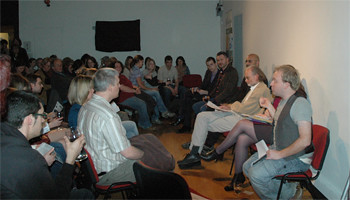The following essay is written by Dr. Jamie Lewis and relates to The Hunger Games sciSCREEN.
Disclaimer: I approach this essay as someone who has not read the books and who has only watched the Hunger Games Part 1.
The central premise of The Hunger Games, that of kids killing each other for public spectacle, is extremely chilling and disturbing. To this end, The Hunger Games revokes memories of William Golding’s dystopian novel ‘Lord of the Flies’, which itself was adapted for film in 1963, and again in 1990. It also has a nod, well more of a bow actually, to the 1975 classic RollerBall in which Jonathan, like Katniss, defeats the purpose of the game by deciding not to kill their opponent; an act which not only changes the rules of the game but an act which presumably sets in motion a challenge to the ruling elite – a spark to ignite the uprising. The film is therefore far more than a killing spree. For me, the film is a commentary on the inequality of society, presented in the increasingly popular young adult action-romance genre that includes films such as the Twilight Saga and the Harry Potter series. However, it is the underpinning social commentary that the film provides which, in my opinion, elevates The Hunger Games above similar contemporary pictures. The film takes us on ride from the past (with references to Roman gladiatorial events and circuses underpinned by a David and Goliath narrative) to the present (of TV screens, trains, and an ever expanding celebrity gaze) and into a future (of forcefields, trackerjackers and genetically engineered animals). To attempt to unpack all of the central threads in the film would therefore be a foolhardy endeavour. There are far too many. For the purposes of this essay I will therefore focus on a couple motifs that interest me as a sociologist.
Safari
‘A journey of expedition, for hunting, exploration or investigation, especially in East Africa.’
In The Hunger Games we are privy to two aspects of the concept of ‘safari’ – ‘the hunt or the search’ and ‘the journey’
The Hunt/ The Search
In one of the first scenes in the film, we find Katniss resisting the State by illegally foraging for food in the forests of District 12. She is hunting food presumably to take home to feed her family. It is the hunting skills she develops growing up in the forests along with other essential survival skills which providers her with the necessary attributes to survive being hunted by a group of contestants during The Hunger Games. To hunt in packs (a nod to our primitive pasts) is a tactic some of the contestants deploy during the games as they target Katniss who they perceive to be a significant threat to them winning the contest.
Whilst we see the concept of hunting in its literal form figure prominently in the film, we also see ‘the hunt’ in a more metaphorical presence. The title of the film mirrors its main event – The Hunger Games - where the hunt is on discover the last ‘tribute’ standing who will be crowned the victor. Such a search is presumably a chilling commentary on the explosion of talent shows such as X Factor, and Britain’s Got Talent that attempt to find the next new star and survival reality shows such as Castaway and 71 Degrees North, which also catapults its contestants into the public domain. Dressed up in more grotesque form, The Hunger Games does far more than create the next star though. The sadistic annual games serves the purpose of distracting those based in the districts from the realities of their life – from poverty, from inequality and from every day hunger. A Marxist might speak of the games as the ‘opium to the masses’ – distracting the unprivileged from the reality of their shared situations. This might explain why the districts have not routinely come together in revolt against the Capitol – an apathy that, in part, borders on voluntary servitude. Of course, Rue’s death watched together by inhabitants of District 11 on one of the large telescreens does cause a communal emotional response – what Durkheim might have called ‘collective effervescence’- that sets in motion a mini riot instigated by Rue’s father. However, that the technology screening the events is seemingly one way, with little opportunity for the citizens of District 11 to communicate with one another other than through communally watching events unfold in controlled areas, meant that a spontaneous mob-like reaction was quashed relatively abruptly. Nevertheless, the tantalising tagline for the next film Catching Fire that ‘every revolution begins with a spark’ suggests that a more significant, organised uprising is not too far away.
The Journey
The film’s central character is Katniss Everdeen and it is through her eyes with which we see most of the world. Katniss’ personal journey is one of adaptation. Ironically, despite its obvious dangers, in many ways she is more comfortable in the virtual forests of The Hunger Games that remind her of the forests she grew up in, than she is in front of the gaze of the TV cameras and during some of the lavish spectacles in the build-up to the main event. In the spotlight, Katniss feels out of place, and much of her training is tailored towards being seen to be more approachable, lucid and confident on camera. Developments in such personal characteristics are a feature of many people’s teenage years (although it may not extend to television appearances). Katniss’ personal development is not the only journey we are taken on in The Hunger Games though. Although situated in a static present, the film juxtaposes ideas of the past, the near past, the near future and a possible dystopian future. The symbolic scene of the train moving from the impoverished boroughs of District 12 whose primary industry is coal, passing through some of the other under-privileged districts predicated on agriculture and livestock through to the wealthy districts that manufacture electronics and weapons is especially poignant. Such a journey reflects some significant human developments – the move from pre-industrial society, to industrial society and into a new technological age of virtual reality and xenotransplantation. Of course, such ‘progression’ is also compartmentalised in today’s world. The districts of Panem could be seen to represent different areas of the world at present. Today, we have societies built on industrialization, others on agriculture, whilst others still have entered a new technological age. These are often conceptualised as stages in a progression in which countries, communities and individuals endeavor to own the products of their own labour.
Surveillance
In the same way that technology is the privilege of the Party in Orwell’s Big Brother, technology is the privilege of the Capitol in The Hunger Games. Technology is used to control, manipulate (sometimes genetically), strike fear (for example, through the release of Wolf Mutts), and for entertainment. As such, the concept of Big Brother in The Hunger Games is a mix of Orwell’s Big Brother in which the state is watching and surveilling its citizens and the UK television programme which places strangers together in a house, locked away from the outside world for around 3 months as a form of voyeuristic entertainment. When speculating as to the reasons the citizens of Panem continue to watch the games year in year out: we might propose tradition, utter fear of the repercussions of resistance, sadistic enjoyment or morbid fascination – in the way we sometimes can’t take our eyes off a road accident. Ironically, though, the extremely violent concept of The Games serves the purpose of pacifying the masses. The tributes are not the only ones surveilled and controlled, so too are the citizen of the districts who watch The Games on the large telescreens.
When scholars write about surveillance, their starting point is often Jeremey Bentham and the panoptican. The panoptican describes the architecture of a prison, where prisoners in a cell may occupy the circumference, whilst the officer is positioned in a watchtower in the centre. From their vantage point, the single watchman or woman can observe all the prisoners, but cannot be seen. This places them in the position of being able to surveill all the prisoners without them knowing they are being watched. Of course, the same systems of surveillance that are built to protect, may be feared for their power to keep track of personal lives, and groups. The control room of the virtual reality games reminds us of this design. But where once surveillance was relatively static focussing on a single space (such as the panoptican), authors such as David Lyon comment on how the means of communication is increasingly mobile and people cannot hope to evade surveillance. In The Hunger Games this is achieved through remote spies such as Tracker Jackers and JabberJays. Even when Katniss moves towards the far-flung boundaries of the virtual forest, she is tracked and chased back towards the centre by a fire ball. This move from the outskirts of the forests back towards its heart also mirrors a central theme in the film. Katniss shuns the limelight, her move to the borders may not have just been a survival technique, it may have also been her yearning for the familiar. Indeed, the comparative privacy of District 12’s forests (the most remote area of the most remote district), which we see at the beginning of the film contrasts with the end of the movie in which Katniss is positioned centre stage in one of a number of celebratory public appearances.








No comments:
Post a Comment